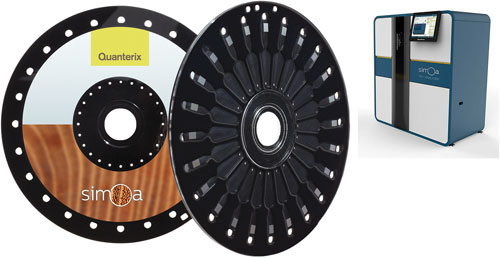February 15, 2016 (Vol. 36, No. 4)
Digital-Style Immunoassays from Quanterix Sense the Earliest, Faintest Wisps of Disease
Quanterix is disrupting diagnostics with a platform capable of measuring individual proteins in a variety of matrices including serum, plasma, cerebrospinal fluid, urine, and cell extracts. The platform’s single-molecule sensitivity makes it possible for users to accurately diagnose conditions, including heart attacks, long before symptoms appear, and to more accurately stratify patients for clinical trials.
Single protein measurement is the key. As Kevin Hrusovsky, executive chairman and CEO, points out, “Proteins capture information about how we live.” That includes environmental as well as genetic factors.
“Proteins in the blood typically are available in only minute quantities, so exquisite levels of sensitivity are needed to detect them,” Hrusovsky elaborates. “Disease increases protein quantities to detectable levels.”
Quanterix’ technology detects those proteins before disease becomes evident. Heart attacks, for instance, are diagnosed by measuring troponin in the blood. The company’s Single Molecule Array (Simoa™) fully automated digital immunoassay platform, Hrusovsky says, makes it possible for users to “measure troponin levels while people are still healthy, before they experience heart attacks.”
Another opportunity is the early detection of concussions. There currently are no blood tests for concussions, but the associated biomarkers can be measured in the cerebral spinal fluid because minute quantities leak across the blood-brain barrier. Quantifying the biomarkers for a concussion, says Hrusovsky, enables physicians to redefine remissions.”
“Virtually every disease releases biomarkers into the blood in very low concentrations,” explains Hrusovsky. “These biomarkers can be important early diagnostic signals.” Consequently, detecting biomarkers associated with a disease or other health problem—such as Alzheimer’s, cancer, a hidden inflammatory condition, or an infectious disease—can reveal whether a patient has it while it is still in its most treatable stages.
“When we can see the most important proteins at very sensitive levels,” states Hrusovsky, “we can shift medicine from the rear-view mirror to health screens that detect disease when it is most easily treated.”
Mechanism of Action
To achieve such sensitivity, extremely specific antibodies are populated onto 500,000 beads less than 5 microns in diameter. The beads that bind to the target protein are then illuminated with a detector antibody and isolated in femtoliter-sized wells. That enables the fluorophores to develop a signal that can be read accurately across a range of more than four logs. Hrusovsky says this specificity is 1,000 times greater than the best immunoassays available today.
“We can read that single protein,” he marvels. “That’s the real magic.”
Simoa can read quantities of proteins, too, peaking at five logs of concentration. Consequently, the diagnostic assay can identify both advancing diseases and the earliest onset of disease. “That’s something no other technology can do,” he asserts.
Rapidly Evolving Possibilities
Urologists at Johns Hopkins used the Quanterix platform to identify patients likely to experience the recurrence of very aggressive prostate cancer. According to Hrusovsky, the urologists identified the recurrence six to nine months earlier than with imaging. That ability interests payers, too, he says.
Simoa’s possibilities are expansive, Hrusovsky tells GEN: “It can detect more than just proteins, identifying DNA, RNA, and microRNA with the sensitivity of PCR but without its sample bias.”
More than 50 peer-reviewed papers on the subject have been published to date, with more than 150 expected by the end of 2016.
The capabilities of Simoa technology were shared at a recent Quanterix user conference in San Francisco. The event attracted 185 current and potential users who took advantage of the opportunity to share results and discuss applications. This May, Quanterix will host another conference, in Boston.
“The data presented at the conference was compelling,” Hrusovsky recalls. “We have the ability to truly change healthcare from sick care to preventive care, using screening tests to determine whether people are trending toward sickness before they are sick.”
Simoa currently is approved for research use only. Looking forward to the fourth quarter of 2016, Hrusovsky says he expects to launch a newly engineered benchtop version of the reader as Simoa 3.0.
In 2017, Quanterix plans to launch laboratory-developed diagnostic tests and point-of-care diagnostics. When Simoa 4.0 is launched later that year, the benchtop reader is expected to also include sample preparation and detection. For 2019, Hrusovsky predicts a partner will launch an in vitro diagnostic kit based on Simoa.
“We’re currently raising a crossover fund to support those new instrument developments and to expand our biomarker menu from 35 to more than 100,” Hrusovsky informs. “We expect to go public in 2016.”

Quanterix’ Simoa™ technology (named for single molecule array) can identify individual proteins in blood to diagnose conditions before symptoms appear. The goal is to anticipate (and potentially prevent) health emergencies such as heart at- tacks, and more accurately strat-ify patients for clinical trials.
Early Promise
Quanterix was formed in 2007. By 2012, it had developed the first Simoa platform. Hrusovsky joined in 2014 at the urging of Bain Capital, a flagship investor. That year the company earned $4 million in sales.
“I realized Quanterix was a much bigger opportunity than was articulated,” Hrusovsky declares. He came to this conclusion after performing due diligence for three months with the team at Caliper Life Sciences, a company he had served as CEO. Hrusovsky decided that Quanterix could change the world if it was appropriately positioned.
Under Hrusovsky’s leadership, Quanterix has experienced six consecutive quarters of 100% growth. Its 2015 sales are expected to approach $12 million, and 2016 sales are projected to reach $24 million, Hrusovsky says, as customers up their usage, and as its geographic reach expands to all of Europe and Asia, in addition to North America.
Quanterix



